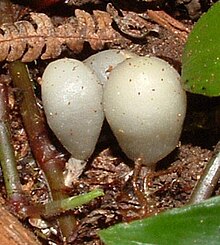
Psilocybe is a genus of gilled mushrooms, growing worldwide, in the family Hymenogastraceae. Many species contain the psychedelic compounds psilocybin and psilocin.
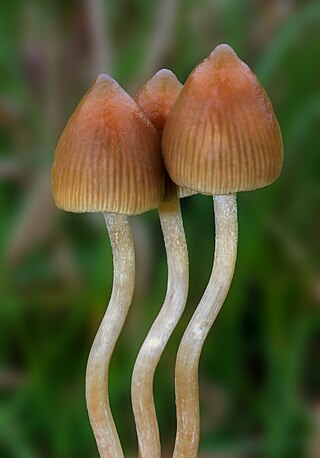
Psilocybe semilanceata, commonly known as the liberty cap, is a species of fungus which produces the psychoactive compounds psilocybin, psilocin and baeocystin. It is both one of the most widely distributed psilocybin mushrooms in nature, and one of the most potent. The mushrooms have a distinctive conical to bell-shaped cap, up to 2.5 cm (1 in) in diameter, with a small nipple-like protrusion on the top. They are yellow to brown, covered with radial grooves when moist, and fade to a lighter color as they mature. Their stipes tend to be slender and long, and the same color or slightly lighter than the cap. The gill attachment to the stipe is adnexed, and they are initially cream-colored before tinting purple to black as the spores mature. The spores are dark purplish-brown in mass, ellipsoid in shape, and measure 10.5–15 by 6.5–8.5 micrometres.

Psilocybe cyanescens, commonly known as the wavy cap or potent psilocybe, is a species of potent psychedelic mushroom. The main compounds responsible for its psychedelic effects are psilocybin and psilocin. It belongs to the family Hymenogastraceae. A formal description of the species was published by Elsie Wakefield in 1946 in the Transactions of the British Mycological Society, based on a specimen she had recently collected at Kew Gardens. She had begun collecting the species as early as 1910. The mushroom is not generally regarded as being physically dangerous to adults. Since all the psychoactive compounds in P. cyanescens are water-soluble, the fruiting bodies can be rendered non-psychoactive through parboiling, allowing their culinary use. However, since most people find them overly bitter and they are too small to have great nutritive value, this is not frequently done.

Psilocybe azurescens is a species of psychedelic mushroom whose main active compounds are psilocybin and psilocin. It is among the most potent of the tryptamine-bearing mushrooms, containing up to 1.8% psilocybin, 0.5% psilocin, and 0.4% baeocystin by dry weight, averaging to about 1.1% psilocybin and 0.15% psilocin. It belongs to the family Hymenogastraceae in the order Agaricales.
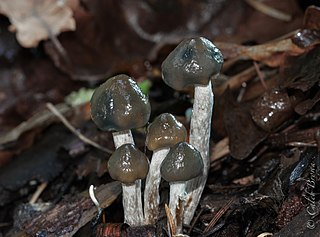
Psilocybe baeocystis is a psilocybin mushroom of the family Hymenogastraceae. It contains the hallucinogenic compounds psilocybin, psilocin and baeocystin. The species is commonly known by various names such as bottle caps, knobby tops, blue bells, olive caps.

Psilocybe caerulipes, commonly known as blue-foot, is a rare psilocybin mushroom of the family Hymenogastraceae, having psilocybin and psilocin as main active compounds. An older synonym is Agaricus caerulipes.
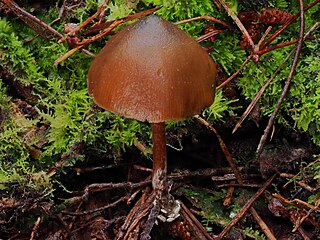
Psilocybe aucklandiae is a species of agaric fungus in the family Hymenogastraceae. The species is known from the Auckland Region of New Zealand, where it grows from clay soils in exotic pine plantations and native forests. It is phylogenetically similar to or almost the same as Psilocybe zapotecorum from Mexico and South America. As a blueing member of the genus Psilocybe it contains the psychoactive compounds psilocin and psilocybin.

Psilocybe subaeruginosa is a species of agaric fungus in the family Hymenogastraceae described in 1927 and known from Australia and New Zealand. As a blueing member of the genus Psilocybe it contains the psychoactive compounds psilocin and psilocybin.

Psilocybe mescaleroensis is a psychedelic mushroom which has psilocybin and psilocin as main active compounds. This mushroom is closely related to Psilocybe hopii and Psilocybe cyanescens. It was brought to scientific attention by Lee Walstad.

Psilocybe stuntzii, also known as Stuntz's blue legs and blue ringers it is a psilocybin mushroom of the family Hymenogastraceae, having psilocybin and psilocin as main active compounds.
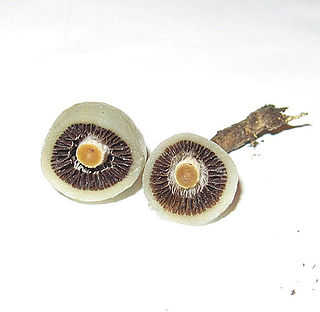
Weraroa was a genus of mushrooms from the families Hymenogastraceae and Strophariaceae. The genus was initially described by mycologist Rolf Singer in 1958 to accommodate the single species Secotium novae-zelandiae reported by Gordon Herriott Cunningham in 1924. It was thought that the genus represented an intermediary evolutionary stage between a hypogeous (underground) ancestor and the related epigeous genus Stropharia. Advances in phylogenetics and taxonomic changes since 1958 found it contained unrelated species from multiple genera. It is now considered a synonym of the genus Psilocybe.
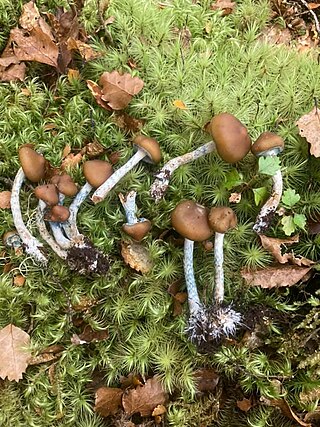
Psilocybe makarorae is a species of psilocybin mushroom in the family Hymenogastraceae. Officially described as new to science in 1995, it is known only from New Zealand, where it grows on rotting wood and twigs of southern beeches. The fruit body (mushroom) has a brownish cap with lighter coloured margins, measuring up to 3.5 cm (1.4 in) wide. The cap shape is either conical, bell-shaped, or flat depending on the age of the mushroom, and it features a prominent umbo. Although the whitish stem does not form a true ring, it retains remnants of the partial veil that covers and protects the gills of young fruit bodies. P. makarorae mushrooms can be distinguished from the similar North American species Psilocybe caerulipes by microscopic characteristics such as the presence of cystidia on the gill faces (pleurocystidia), and cheilocystidia with more elongated necks. Based on the bluing reaction to injury, P. makarorae is presumed to contain the psychedelic compounds psilocybin and psilocin.
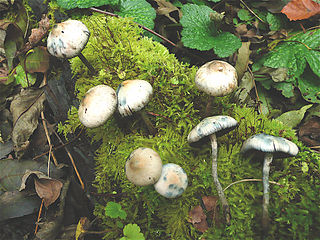
Psilocybe serbica is a species of mushroom in the family Hymenogastraceae. The mushroom contains the psychotropic compounds psilocybin and psilocin, and also related tryptamine alkaloids baeocystin, norbaeocystin, and aeruginascin. It is closely related to Psilocybe aztecorum. It was reported as new to science by Meinhard Moser and Egon Horak in 1969. Molecular analysis published in 2010 has shown that P. serbica is the same species as Psilocybe bohemica described by Šebek in 1983, Psilocybe arcana described by Borovička and Hlaváček in 2001, and Psilocybe moravica by Borovička in 2003. Psilocybe serbica is common in Central Europe.

Psilocybe subcubensis is an entheogenic species of mushroom in the family Hymenogastraceae. The mushroom contains the medicinal compounds psilocybin and psilocin. Psilocybe subcubensis was first described by Mexican mycologist Gaston Guzman. It is the pantropical sister species of Psilocybe cubensis. It is macroscopically identical to P. cubensis but has smaller spores.
Psilocybe tasmaniana is a species of coprophilous agaric fungus in the family Hymenogastraceae. It was described by Gastón Guzmán and Roy Watling in 1978 as a small tawny orange mushroom that grows on dung, with a slight blueing reaction to damage, known only from Tasmania and southeastern Australia. It was likened to Psilocybe subaeruginosa although characteristics, appearance, and the association with dung were not typical for that species. As a blueing member of the genus Psilocybe it contains the psychoactive compounds psilocin and psilocybin.

Cortinarius porphyroideus, commonly known as purple pouch fungus, is a secotioid species of fungus endemic to New Zealand. It was one of six species that appeared as part of a series depicting native New Zealand fungi on stamps, released in 2002.

Psilocybe allenii is a species of agaric fungus in the family Hymenogastraceae. Described as new to science in 2012, it is named after John W. Allen, who provided the type collection. It is found in the northwestern North America from British Columbia, Canada to Los Angeles, California, most commonly within 10 miles (16 km) of the Pacific coast.

Clavogaster virescens is a species of secotioid or pouch-like fungus in the family Strophariaceae. It is endemic and indigenous to New Zealand, where it grows on rotting wood in native bush and mixed native and introduced forests. It has a stout yellowish stem, and a powder blue, purplish or greenish blue cap that forms a pouch, often referred to as a peridium, enclosing reddish brown or orange chambered gleba. The species is sometimes known as the "Spindle Pouch".
